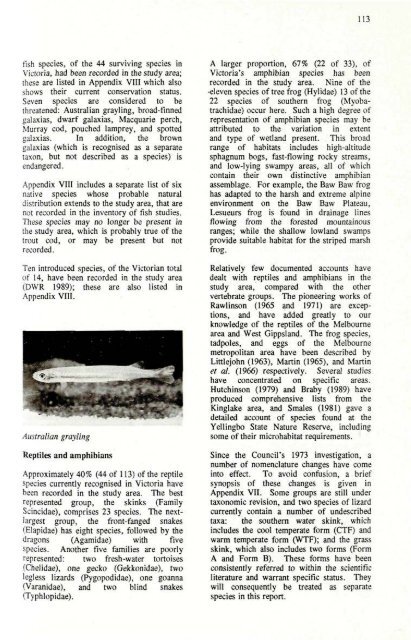Factors Affecting Flora Conservation - Victorian Environmental ...
Factors Affecting Flora Conservation - Victorian Environmental ...
Factors Affecting Flora Conservation - Victorian Environmental ...
You also want an ePaper? Increase the reach of your titles
YUMPU automatically turns print PDFs into web optimized ePapers that Google loves.
113<br />
fish species, of the 44 surviving species in<br />
Victoria, had been recorded in the study area;<br />
these are listed in Appendix VIII which also<br />
shows their current conservation status.<br />
Seven species are considered to be<br />
threatened; Australian grayling, broad-finned<br />
galaxias, dwarf galaxias, Macquarie perch,<br />
Murray cod, pouched lamprey, and spotted<br />
galaxias. In addition, the brown<br />
galaxias (which is recognised as a separate<br />
taxon, but not described as a species) is<br />
endangered.<br />
Appendix VIII includes a separate list of six<br />
native species whose probable natural<br />
distribution extends to the study area, that are<br />
not recorded in the inventory of fish studies.<br />
These species may no longer be present in<br />
the study area, which is probably tme of the<br />
trout cod, or may be present but not<br />
recorded.<br />
Ten introduced species, of the <strong>Victorian</strong> total<br />
of 14, have been recorded in the study area<br />
(DWR 1989); these are also listed in<br />
Appendix VIII.<br />
P<br />
1<br />
^mi<br />
V<br />
mk<br />
0.<br />
r -V"'<br />
W^<br />
1 •<br />
..„., .<br />
p<br />
Australian grayling<br />
m<br />
. •!• \ - - -<br />
-- :^<br />
' . * * . . " ,<br />
Reptiles and amphibians<br />
^<br />
•<br />
' • > '•<br />
1<br />
•=g ^^^B^^<br />
m^&<br />
,-':<br />
••s<br />
-i-^"<br />
*••'"-«%;"'•<br />
^1<br />
k^<br />
.^.<br />
Approximately 40% (44 of 113) of the reptile<br />
species currently recognised in Victoria have<br />
been recorded in the study area. The best<br />
represented group, the skinks (Family<br />
Sclncidae), comprises 23 species. The nextlargest<br />
group, the front-fanged snakes<br />
(Elapidae) has eight species, followed by die<br />
dragons (Agamidae) with five<br />
species. Another five families are poorly<br />
represented: two fresh-water tortoises<br />
(Chelidae), one gecko (Gekkonidae), two<br />
legless lizards (Pygopodidae), one goanna<br />
(Varanidae), and two bl ind snakes<br />
(Typhlopidae).<br />
A larger proportion, 67% (22 of 33), of<br />
Victoria's amphibian species has been<br />
recorded in the study area. Nine of the<br />
•eleven species of tree frog (Hylidae) 13 ofthe<br />
22 species of southem frog (Myobatrachidae)<br />
occur here. Such a high degree of<br />
representation of amphibian species may be<br />
attributed to the variation in extent<br />
and type of wedand present. This broad<br />
range of habitats includes high-altitude<br />
sphagnum bogs, fast-flowing rocky streams,<br />
and low-lying swampy areas, all of which<br />
contain their own distinctive amphibian<br />
assemblage. For example, the Baw Baw frog<br />
has adapted to the harsh and extreme alpine<br />
environment on the Baw Baw Plateau,<br />
Lesueurs frog is found in drainage lines<br />
flowing from the forested mountainous<br />
ranges; while the shallow lowland swamps<br />
provide suitable habitat for the striped marsh<br />
frog.<br />
Relatively few documented accounts have<br />
dealt with reptiles and amphibians in the<br />
study area, compared with the other<br />
vertebrate groups. The pioneering works of<br />
Rawlinson (1965 and 1971) are exceptions,<br />
and have added greatly to our<br />
knowledge of the reptiles of the Melbourne<br />
area and West Gippsland. The frog species,<br />
tadpoles, and eggs of the Melbourne<br />
metropolitan area have been described by<br />
Llttlejohn (1963), Martin (1965), and Martin<br />
et al. (1966) respectively. Several studies<br />
have concentrated on specific areas.<br />
Hutchinson (1979) and Braby (1989) have<br />
produced comprehensive lists from the<br />
Kinglake area, and Smales (1981) gave a<br />
detailed account of species found at the<br />
YeUingbo State Nature Reserve, including<br />
some of their microhabitat requirements.<br />
Since the CouncU's 1973 invesfigation, a<br />
number of nomenclature changes have come<br />
into effect. To avoid conftislon, a brief<br />
synopsis of these changes is given in<br />
Appendix VII. Some groups are still under<br />
taxonomic revision, and two species of lizard<br />
currendy contain a number of undescribed<br />
taxa: the southem water skink, which<br />
includes die cool temperate form (CTF) and<br />
warm temperate form (WTF); and the grass<br />
skink, which also includes two forms (Form<br />
A and Form B). These forms have been<br />
consistenfly referred to within the scientific<br />
literature and wamant specific status. They<br />
will consequently be treated as separate<br />
species in this report.
















